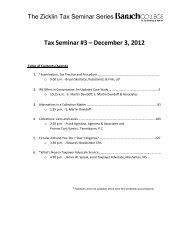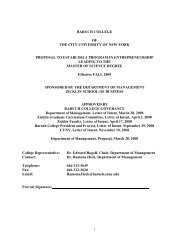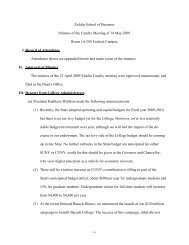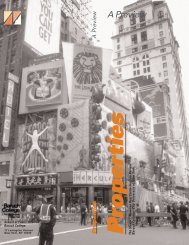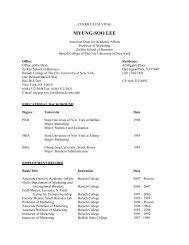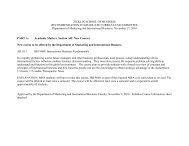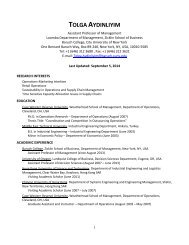Current Financial Reporting Trends
Current Financial Reporting Trends: - Zicklin School of Business
Current Financial Reporting Trends: - Zicklin School of Business
- No tags were found...
Create successful ePaper yourself
Turn your PDF publications into a flip-book with our unique Google optimized e-Paper software.
As suggested by the Staff, Management will revise future filings to clarify our revenue recognition<br />
policy to provide in clear and complete detail the information necessary for a reader to<br />
understand the application of the Company's revenue recognition methods relative to its<br />
various product and service offerings. Our proposed revision to our Summary of Significant<br />
Accounting Policies in future filings is provided below.<br />
Filtration / Fluid Flow Operating Unit:<br />
Within the Filtration / Fluid Flow operating unit, approximately 75% of operating unit<br />
revenues (30% of consolidated revenues) are recognized when products are delivered (when<br />
title and risk of ownership transfers) or when services are performed for unaffiliated customers.<br />
Approximately 25% of operating unit revenues (10% of consolidated revenues) is recorded under<br />
the percentage-of-completion provisions of SOP 81-1, "Accounting for Performance of<br />
Construction-Type and Certain Production-Type Contracts." Products accounted for under SOP<br />
81-1 include the design, development and manufacture of complex fluid control products, quiet<br />
valves, manifolds and systems primarily for the aerospace and military markets. For arrangements<br />
that are accounted for under SOP 81-1, the Company estimates profit as the difference between<br />
total estimated revenue and total estimated cost of a contract and recognizes these revenues and<br />
costs based on units delivered. The percentage-of-completion method of accounting involves the<br />
use of various estimating techniques of expected costs at completion.<br />
Communications Segment:<br />
Within the Communications segment, approximately 90% of the segment's revenue arrangements<br />
(30% of consolidated revenues) contain software components. Revenue under these<br />
arrangements is recognized in accordance with Statement of Position 97-2 (SOP 97-2), “Software<br />
Revenue Recognition,” as amended by SOP 98-9, "Modification of SOP 97-2, Software Revenue<br />
Recognition, with Respect to Certain Transactions." The segment's software revenue<br />
arrangements generally include multiple products and services, or "elements" consisting of meter<br />
and substation hardware, meter reading system software, software support (post-contract<br />
customer support "PCS") and program management support. These arrangements typically require<br />
the Company to deliver software at the inception of the arrangement while the hardware, software<br />
support and program management support are delivered over the contractual deployment period.<br />
These revenue arrangements are divided into separate units of accounting if the delivered item(s)<br />
has value to the customer on a stand-alone basis, there is objective and reliable evidence of the<br />
fair value of the undelivered item(s) and delivery/performance of the undelivered item(s) is<br />
probable. For multiple element arrangements, revenue is allocated to the individual elements<br />
based on vendor-specific objective evidence of fair value ("VSOE") of the individual elements.<br />
The application of these principles requires judgment, including the determination of whether a<br />
software arrangement includes multiple elements and estimates of the fair value of the elements.<br />
The VSOE of the undelivered elements is determined based on the historical evidence of standalone<br />
sales of these elements to customers. Hardware revenues are generally recognized at the<br />
time of shipment or receipt by customer depending upon contract terms. VSOE generally does not<br />
exist for the software element, therefore, the Company uses the residual method to recognize<br />
revenue when VSOE exists for all other undelivered elements. Under the residual method, the fair<br />
value of the undelivered elements is deferred and the remaining portion of the arrangement fee is<br />
recognized as revenue.<br />
SOP 97-2 requires the seller of software that includes post-contract customer support (PCS) to<br />
establish VSOE of the undelivered element of the contract in order to account separately for the<br />
PCS revenue. The Company determines VSOE by a consistent pricing of PCS and PCS renewals<br />
as a percentage of the software license fees and by reference to contractual renewals, when the<br />
renewal terms are substantive. Revenues for PCS are recognized ratably over the maintenance<br />
term specified in the contract (generally in 12 monthly increments). Revenues for program<br />
management support are recognized when services have been provided. The Company<br />
6



